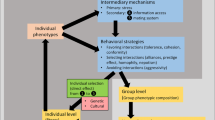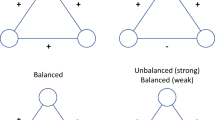Abstract
In recent years, animal social interactions have received much attention in terms of personality research (e.g. aggressive or cooperative interactions). However, other components of social behaviour such as those describing the intensity, frequency, directedness and individual repeatability of interactions in animal groups have largely been neglected. Network analysis offers a valuable opportunity to characterize individual consistency of traits in labile social groups and therein provide novel insights to personality research in ways previously not possible using traditional techniques. Should individual network positions be consistently different between individuals under changing conditions, they might reflect expressions of an individual's personality. Here, we discuss a conceptual framework for using network analyses to infer the presence of individual differences and present a statistical test based on randomization techniques for testing the consistency of network positions in individuals. The statistical tools presented are useful because if particular individuals consistently occupy key positions in social networks, then this is also likely to have consequences for their fitness as well as for that of others in the population. These consequences may be particularly significant since individual network position has been shown to be important for the transmission of diseases, socially learnt information and genetic material between individuals and populations.

Similar content being viewed by others
References
Bell AM, Hankison SJ, Laskowski KL (2009) The repeatability of behaviour: a meta-analysis. Anim Behav 77:771–783
Budaev SV (2010) Using principal components and factor analysis in animal behaviour research: caveats and guidelines. Ethology 116:472–480
Cote J, Dreiss A, Clobert J (2008) Social personality trait and fitness. Proc R Soc Lond B 275:2851–2858
Croft DP, James R, Krause J (2008) Exploring animal social networks. Princeton University Press, Princeton
Croft DP, Krause J, Darden SK, Ramnarine IW, Faria JJ, James R (2009) Behavioural trait assortment in a social network: patterns and implications. Behav Ecol Sociobiol 63:1495–1503
Croft DP, Madden JR, Franks DW, James R (2011) Hypothesis testing in animal social networks. Trends Ecol Evol 26:502–507
Darden SK, James R, Ramnarine IW, Croft DP (2009) Social implications of the battle of the sexes: sexual harassment disrupts female sociality and social recognition. Proc R Soc Lond B 276:2651–2656
Dingemanse NJ, Wolf M (2010) Recent models for adaptive personality differences: a review. Philos T R Soc B 365:3947–3958
Dingemanse NJ, Dochtermann N, Wright J (2010a) A method for exploring the structure of behavioural syndromes to allow formal comparison within and between data sets. Anim Behav 79:439–450
Dingemanse NJ, Kazem AJN, Réale D, Wright J (2010b) Behavioural reaction norms: animal personality meets individual plasticity. Trends Ecol Evol 25:81–89
Dingemanse NJ, Dochtermann N, Nakagawa S (2012) Defining behavioural syndromes and the role of “syndrome deviation” in understanding. Behav Ecol Sociobiol. doi:10.1007/s00265-012-1416-2
Dingemanse NJ, Dochtermann NA (2012) Quantifying individual variation in behaviour: mixed-effect modelling approaches. J Anim Ecol. doi:10.1111/1365-2656.12013
Dochtermann NA, Jenkins SH (2007) Behavioural syndromes in Merriam's kangaroo rats (Dipodomys merriami): a test of competing hypotheses. Proc R Soc Lond B 274:2343–2349
Dochtermann NA, Jenkins SH (2011) Multivariate methods and small sample sizes. Ethology 117:95–101
Drewe JA (2010) Who infects whom? Social networks and tuberculosis transmission in wild meerkats. Proc R Soc Lond B 277:633–642
Ellison NB, Steinfield C, Lampe C (2007) The benefits of Facebook “friends:” social capital and college students' use of online social network sites. J Comput-Mediat Comm 12:1143–1168
Flack JC, Girvan M, de Waal FBM, Krakauer DC (2006) Policing stabilizes construction of social niches in primates. Nature 439:426–429
Fowler JH, Dawes CT, Christakis NA (2009) Model of genetic variation in human social networks. P Natl Acad Sci USA 106:1720–1724
Franz M, Nunn CL (2009) Network-based diffusion analysis: a new method for detecting social learning. Proc R Soc Lond B 276:1829–1836
Frere CH, Kruetzen M, Mann J, Connor RC, Bejder L, Sherwin WB (2010) Social and genetic interactions drive fitness variation in a free-living dolphin population. P Natl Acad Sci USA 107:19949–19954
Hadfield JD, Wilson AJ, Garant D, Sheldon BC, Kruuk LEB (2010) The misuse of BLUP in ecology and evolution. Am Nat 175:116–125
Hamede RK, Bashford J, McCallum H, Jones M (2009) Contact networks in a wild Tasmanian devil (Sarcophilus harrisii) population: using social network analysis to reveal seasonal variability in social behaviour and its implications for transmission of devil facial tumour disease. Ecol Lett 12:1147–1157
Horne TJ, Ylonen H (1998) Heritabilities of dominance-related traits in male bank voles (Clethrionomys glareolus). Evolution 52:894–899
Jacoby DMP, Busawon DS, Sims DW (2010) Sex and social networking: the influence of male presence on social structure of female shark groups. Behav Ecol 21:808–818
Krause J, Ruxton GD (2002) Living in groups. Oxford University Press, Oxford
Krause J, Croft DP, James R (2007) Social network theory in the behavioural sciences: potential applications. Behav Ecol Sociobiol 62:15–27
Krause J, James R, Croft DP (2010) Personality in the context of social networks. Philos T R Soc B 365:4099–4106
Krause J, Wilson ADM, Croft DP (2011) New technology facilitates the study of social networks. Trends Ecol Evol 26:5–6
Lea AJ, Blumstein DT, Wey TW, Martin JGA (2010) Heritable victimization and the benefits of agonistic relationships. P Natl Acad Sci USA 107:21587–21592
Lusseau D, Newman MEJ (2004) Identifying the role that animals play in their social networks. Proc R Soc Lond B 271:S477–S481
Madadhain J, Fisher D, Smyth P, White S, Boey YB (2005) Analysis and visualization of network data using JUNG. J Stat Softw 10:1–35
Manly BFJ (2007) Randomization, bootstrap, and Monte Carlo methods in biology, 3rd edn. Chapman and Hall, Boca Raton
McDonald DB (2007) Predicting fate from early connectivity in a social network. P Natl Acad Sci USA 104:10910–10914
McGhee KE, Travis J (2010) Repeatable behavioural type and stable dominance rank in the bluefin killifish. Anim Behav 79:497–507
Moore AJ (1990) The inheritance of social dominance, mating behaviour and attractiveness to mates in male Nauphoeta cinerea. Anim Behav 39:388–397
Newman MEJ (2003) The structure and function of complex networks. Siam Rev 45:167–256
Oh KP, Badyaev AV (2010) Structure of social networks in a passerine bird: consequences for sexual selection and the evolution of mating strategies. Am Nat 176:E80–E89
Otterstatter MC, Thomson JD (2007) Contact networks and transmission of an intestinal pathogen in bumble bee (Bombus impatiens) colonies. Oecologia 154:411–421
Pike TW, Samanta M, Lindstrom J, Royle NJ (2008) Behavioural phenotype affects social interactions in an animal network. Proc R Soc Lond B 275:2515–2520
Réale D, Reader SM, Sol D, McDougall PT, Dingemanse NJ (2007) Integrating animal temperament within ecology and evolution. Biol Rev 82:291–318
Ryder TB, McDonald DB, Blake JG, Parker PG, Loiselle BA (2008) Social networks in the lek-mating wire-tailed manakin (Pipra filicauda). Proc R Soc Lond B 275:1367–1374
Shizuka D, McDonald DB (2012) A social network perspective on measurements of dominance hierarchies. Anim Behav 83:925–934
Sih A, Watters JV (2005) The mix matters: behavioural types and group dynamics in water striders. Behaviour 142:1417–1431
Sih A, Bell A, Johnson JC (2004) Behavioral syndromes: an ecological and evolutionary overview. Trends Ecol Evol 19:372–378
Sih A, Hanser SF, McHugh KA (2009) Social network theory: new insights and issues for behavioral ecologists. Behav Ecol Sociobiol 63:975–988
Sih A, Cote J, Evans M, Fogarty S, Pruitt J (2012) Ecological implications of behavioural syndromes. Ecol Lett 15:278–289
Webster MM, Ward AJW (2011) Personality and social context. Biol Rev 86:759–773
Wey T, Blumstein DT, Shen W, Jordan F (2008) Social network analysis of animal behaviour: a promising tool for the study of sociality. Anim Behav 75:333–344
Wilson ADM, Krause J (2012a) Metamorphosis and animal personality: a neglected opportunity. Trends Ecol Evol 27:529–531
Wilson ADM, Krause J (2012b) Personality and metamorphosis: is behavioral variation consistent across ontogenetic niche shifts? Behav Ecol. doi:10.1093/beheco/ars123
Wilson ADM, Godin J-GJ, Ward AJW (2010a) Boldness and reproductive fitness correlates in the eastern mosquitofish, Gambusia holbrooki. Ethology 116:96–104
Wilson AJ, Réale D, Clements MN, Morrissey MM, Postma E, Walling CA, Kruuk LEB, Nussey DH (2010b) An ecologist's guide to the animal model. J Anim Ecol 79:13–26
Wolf M, Weissing FJ (2010) An explanatory framework for adaptive personality differences. Philos T R Soc B 365:3959–3968
Wolf M, Weissing FJ (2012) Animal personalities: consequences for ecology and evolution. Trends Ecol Evol 27:452–461
Acknowledgments
We would like to thank Max Wolf and Dick James for helpful discussions and suggestions for the manuscript. ADMW was supported by a postdoctoral research fellowship from the Alexander von Humboldt foundation. NJD was supported by the Max Planck Society. We would also like to thank Darren Croft and two anonymous reviewers for comments and suggestions.
Author information
Authors and Affiliations
Corresponding author
Additional information
Communicated by D. P. Croft
Rights and permissions
About this article
Cite this article
Wilson, A.D.M., Krause, S., Dingemanse, N.J. et al. Network position: a key component in the characterization of social personality types. Behav Ecol Sociobiol 67, 163–173 (2013). https://doi.org/10.1007/s00265-012-1428-y
Received:
Revised:
Accepted:
Published:
Issue Date:
DOI: https://doi.org/10.1007/s00265-012-1428-y




